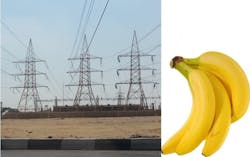In New York City, there aren’t that many gas stations, but there are many fruit stands and food carts (you may know that by their street name: halal cart). Lately, the number of stands and carts has increased significantly, such that in some places, there may be four or five carts next to one another, all selling the exact same product.
So basically there are hundreds or thousands of places you can get your bananas and/or hot dogs from, yet the cost for the same banana or hot dog varies significantly; in some areas you can get five (5) or more bananas for a dollar, other areas you can only get 1 banana for a dollar; in other areas you will probably pay a dollar just to look at a banana.
The reason for the huge cost variance is mainly tied to “location”, i.e. rent for different apartments vary significantly by location; carts/stands still have to pay rent/lease.
The most expensive project for a utility is building a substation or power plant, of course the substation and power plant equipment are extremely expensive, but in some areas the land may be more expensive than all the equipment combined. To make things worse, you may have the necessary funding, but you cannot find available property; most likely the land you will find will not be properly zoned; you will also have to go through the “not in my backyard” struggle and the land will most likely be an environmental waste hazard that will require ton of cash for cleaning up. Ideally, we want the station closer to the load center; however, we may be forced to build the station further which complicates other matters.
That’s why building a substation is usually the last resort, especially when the substation is needed to meet a forecasted load increase that may occur for few hours every few years. Peak shaving is the direction utilities and regulatory commission are adopting: via using renewable energy, i.e. mixing solar and batteries to meet those few hours; again, implementing other measures to defer the need to acquire property, especially areas where a banana cost more than a dollar.
The next time you are planning a substation, check how much bananas cost in the proposed location.
About the Author
Ahmed Mousa
Principal Engineer/Adjunct Professor/Board Member/Founder & CEO
Ahmed Mousa, M.S.E.E., has over 12 years of experience in transmission, sub-transmission, substations and distribution systems with industry leaders such as Consolidated Edison, PSE&G, PEPCO, and First Energy. He is a subject matter expert in transmission/sub-transmission, distribution and substation planning. Ahmed has years of expertise conducting PSS/E load flows, i.e. forced & scheduled outages analysis, phase angle studies, voltage analysis, network/non-network load transfers. Ahmed provides analysis and support during heat waves, storms and other system emergencies.
Mr. Mousa is an Adjunct Professor at New Jersey Institute of Technology (NJIT) teaching advanced topics graduate electrical engineering courses.
Mr. Mousa serves on the New Jersey Association of Energy Engineers board as a board member.
Mr. Mousa is currently the Principal Engineer at PSE&G in the Electric Delivery Planning section, where he is responsible for managing power system generation, transmission and distribution simulation studies, developing the short/ long range substation forecasts, analysis and load relief, performing short circuit studies, performing breaker duty analysis, developing transmission and distribution station and feeder designs, reviewing large customer demand proposals. Mr. Mousa is responsible for all Distributed Energy Resources technical evaluations and interconnection agreements.
Mr. Mousa is the Founder/CEO of The Electric Bridge Consulting firm assisting large and small utilities, colleges/universities & consulting firms by providing electric utility services, educational/training services, consulting services, leadership seminars, career consulting, lecturing services, electric professional engineering courses & national & international webinars.
Mr. Mousa was responsible for the short term, long term (1/5/10/20/30 years), and emergency planning for the area substation, transmission / sub-transmission feeders and the 4 kV system at Consolidated Edison. He has conducted several studies on the impact of electric vehicles, distributed generation, steam to AC conversion, energy efficiency models, and R&D initiatives on the distribution and transmission system.
Mr. Mousa was the project manager for a SCADA GE XA21 Energy Management System and the project manager and project engineer for President Obama’s Department of Energy stimulus grant for Consolidated Edison’s 4 kV system.
Awards include the 2009 3rd Quarter Distribution Engineering ALVA Award for 21st Century Leader, the 2012 “Sustain Energy Reliability” Team Award, and the 2013 Excellence in Design and Genius Engineer (EDGE) Award Nominee for “Developed Load Calculation Tools for System and Transmission Operations.” He has over eight years of experience in providing training in a wide range of subjects including PSS/E, 4 kV systems, distributed generation grid adoption, system operation outage analysis, transformer ratings, voltage studies, basic and advanced power flow, intermeshes, phase angle studies, capacitor bank impact on the grid, smart grid, plant information (PI), post contingency analysis, voltage reduction, and conservation voltage optimization. Mr. Mousa received his Bachelor's Degree in Electrical Engineering from Stony Brook University and later a Master's Degree in Electrical Engineering from Manhattan College and has completed the Siemens PTI Distribution and Transmission courses.

